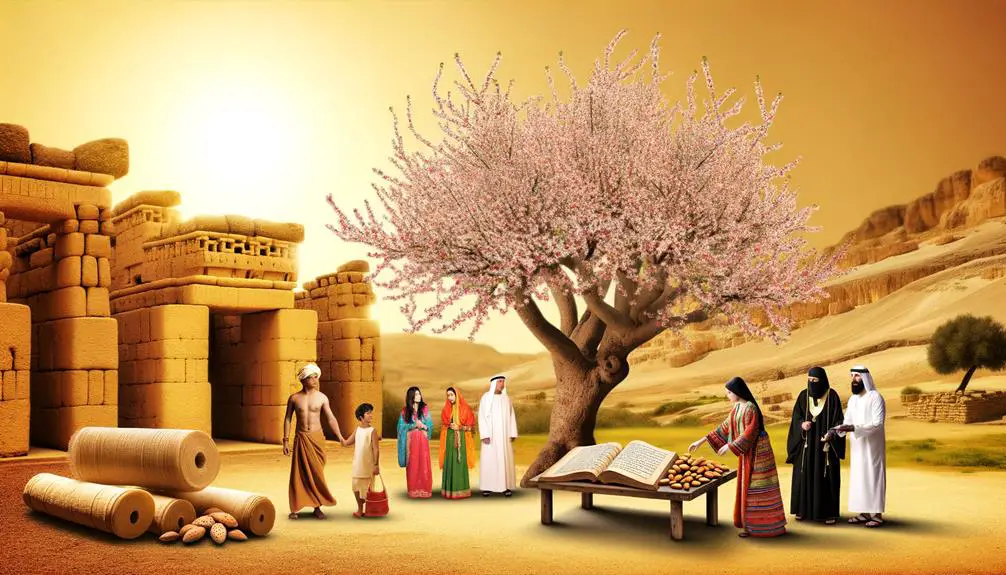In the Bible, almonds symbolize divine watchfulness and approval, revealing layers of spiritual significance that beckon deeper exploration.

Meaning of Almonds in the Bible
You might not be aware that almonds carry a profound symbolism in the Bible, far beyond their nutritional value. They're not just snacks; in biblical times, they were powerful symbols of watchfulness, promise, and divine approval, as illustrated in the story of Aaron's rod that budded almonds overnight.
This event isn't just an ancient tale; it holds deep spiritual significance, linking the almond with themes of miraculous change and God's endorsement. To fully grasp the layers of meaning these nuts have in biblical narratives and how they've influenced cultural and spiritual practices over millennia, one must explore the interconnected stories and symbols found within the sacred texts.
Key Takeaways
- Almonds symbolize watchfulness, promise, and divine favor in biblical narratives.
- The blossoming of Aaron's rod represents divine approval and leadership validation.
- In ancient rituals and prophecy, almonds are used to signify divine oversight and the anticipation of God's promises.
- Almonds hold cultural and spiritual significance, enhancing religious contexts and symbolizing spiritual nourishment and growth.
Almonds: Symbolism and Significance

Why do almonds hold such profound symbolism in biblical texts? To understand this, you've got to delve into their inherent qualities and how these have been perceived over millennia. Almonds, beyond their nutritional value, embody themes of watchfulness, promise, and the dawning of God's favor, which are woven intricately into the fabric of biblical narratives.
Almonds aren't just a source of sustenance but a symbol rich in meaning. Their mention in the Bible carries a weight that transcends the mere physical presence of the nut. The nutritional value of almonds is well-documented, packed with proteins, healthy fats, and vitamins, which in ancient times, made them a highly prized food source. This nutritional wealth translates into a metaphor for spiritual and physical sustenance in biblical lore, suggesting a divine providence that nourishes and sustains life.
Moreover, the almond tree is among the first to awaken from its winter sleep, its blossoms heralding the arrival of spring. This characteristic imbues almonds with a symbolism of watchfulness and a promise of renewal, themes that resonate deeply in biblical texts where watchfulness and renewal are recurrent motifs.
Yet, it's not just their symbolic significance that makes almonds stand out in biblical references. Almond recipes, from those times, likely served as more than mere sustenance; they were a way to celebrate the profound spiritual and physical nourishment these nuts provided. These dishes would have been a testament to the almond's revered status, blending its rich nutritional profile with its deep spiritual symbolism, thereby enriching the cultural and religious tapestry of the time.
Aaron's Rod and Divine Approval

You'll find that Aaron's rod blossoming is a pivotal moment in biblical narratives, underscoring divine selection and approval. This incident not only signifies God's clear choice of Aaron and his lineage for the priesthood but also imbues almonds with profound theological symbolism.
Through this act, almonds become a tangible sign of legitimacy and divine favor, reinforcing the sacrosanct nature of Aaron's priesthood.
Aaron's Rod Blossoms
In the biblical narrative, Aaron's rod blossoming serves as a divine sign of his legitimate priesthood and God's approval, highlighting a pivotal moment of leadership confirmation within the Israelite community. This event, far from being merely anecdotal, underscores a profound theological assertion about divine selection and endorsement.
The rod, a symbol of authority and leadership, undergoes a transformation that can only be described as a blossoming miracle. This miraculous event unequivocally affirms Aaron's role and by extension, the Levitical priesthood's divine ordination. It's a testament to the fact that true leadership and authority within the sacred context aren't self-appointed but are validated through clear signs of divine favor.
This narrative element serves to underscore the intertwining of divine will with leadership legitimacy.
Symbolizing God's Choice
Aaron's rod blossoming not only marked a pivotal moment in biblical history but also served as a clear symbol of God's choice, definitively approving Aaron's priesthood and leadership among the Israelites. This event underscored the concept of divine selection, using a seemingly ordinary object, an almond rod, to convey a profound message.
The spontaneous flowering signified chosen symbolism, highlighting the unique status and divine endorsement of Aaron's lineage over others. This wasn't merely about a miraculous occurrence; it was a deliberate demonstration of divine will, establishing a visual and tangible sign of authority and favor.
Through this act, the almond rod transcends its natural state, embodying a divine selection process, and reinforcing the sacred bond between God's will and His chosen leaders.
The Golden Lampstand Explained

You'll find that the Golden Lampstand, or Menorah, holds profound symbolism within its design, intricately tied to almonds and the manifestation of divine presence.
Its construction materials and craftsmanship further underscore the deep religious and cultural significance attributed to it in biblical texts.
This examination will reveal how every aspect of the Lampstand's design is meticulously imbued with theological implications, inviting a richer understanding of its role in sacred rituals.
Symbolism of Lampstand Design
Delving into the symbolism behind the lampstand design in the Bible reveals how its intricate details encapsulate profound spiritual meanings, particularly in the context of divine illumination and guidance.
The use of olive oil, a pure substance, in lighting techniques is emblematic of purity, enlightenment, and anointing, serving as a conduit for divine wisdom.
This choice of fuel, coupled with the lampstand's design, underscores the intentionality behind creating a sacred space illuminated by a light that symbolizes God's presence and guidance.
The light from the lampstand, fueled by olive oil, not only physically illuminated the tabernacle but also metaphorically represented divine light guiding the faithful, offering them insight and direction in their spiritual journey.
Almonds and Divine Presence
Exploring the symbolism of almonds within the context of the golden lampstand unveils their representation of divine presence and watchfulness in biblical narratives. The almond, blossoming early in the year, signals the almond harvest, a period of awakening and renewal, paralleling spiritual vigilance and enlightenment.
This imagery isn't accidental but a meticulously crafted nutritional metaphor, where the almond embodies sustenance for the soul, akin to its physical nourishment. Thus, the incorporation of almond motifs in the golden lampstand isn't merely decorative but imbues the artifact with layers of meaning, reinforcing the idea of God's perpetual oversight and provision.
Through this lens, the almond transcends its botanical identity, becoming a symbol of divine watchfulness and a reminder of spiritual sustenance.
Construction Materials and Craftsmanship
In examining the golden lampstand, one must appreciate the meticulous selection of construction materials and craftsmanship that underscore its profound symbolism and functionality. The creation of this sacred object wasn't merely an act of religious devotion; it was a demonstration of advanced techniques in stone quarrying and the expertise of artisan guilds.
Aspect |
Detail |
|---|---|
Material Source |
Stone quarrying techniques provided durable materials for construction, ensuring longevity and symbolism. |
Craftsmanship |
Artisan guilds applied intricate designs, embodying spiritual meanings and craftsmanship excellence. |
Symbolism |
Materials and craftsmanship techniques combined to symbolize divine light and guidance. |
Functionality |
Precision in craftsmanship ensured the lampstand's practical use in rituals, enhancing its sacred role. |
This careful blend of materials and skill highlights a deep understanding of both the spiritual and practical needs of the time.
Almonds in Ancient Rituals

Almonds held a significant role in ancient rituals, symbolizing watchfulness and promise due to their early flowering. Beyond their aesthetic appeal, the cultivation of almonds was deeply intertwined with ancient societies, reflecting a profound understanding of their environment and the agricultural practices they developed. Almond cultivation wasn't merely about harnessing the land for food; it was a nuanced art that mirrored the societal values and religious beliefs of the time. The process of growing almonds, from planting to harvest, was laden with symbolic meaning, often tied to themes of renewal and purity.
The nutritional symbolism of almonds also played a crucial part in their ritualistic use. Rich in proteins, vitamins, and minerals, almonds weren't just food but a symbol of sustenance and health. Their inclusion in rituals was multifaceted; they were offerings meant to invoke divine favor, components of ceremonial meals signifying communal well-being, and tokens of prosperity and strength. This nutritional aspect heightened the almond's significance in rituals, making it a powerful emblem of life and vitality.
In analyzing these ancient practices, you uncover a layer of cultural depth where almonds are more than mere nuts. They emerge as vital components in the tapestry of ancient life, embodying the intertwined nature of spirituality, sustenance, and society. Their role in rituals transcends simple agricultural success to encompass broader themes of life, renewal, and the cyclical nature of existence, offering a window into the ancient world's relationship with nature and the divine.
Watchfulness and Promise

Significantly, the symbolism of watchfulness and promise attributed to almonds in biblical contexts offers a profound insight into their perceived spiritual and existential importance. In the scriptures, almonds aren't merely agricultural products but embody deeper spiritual meanings, intertwining with themes of vigilance and divine fulfillment.
- Almond Harvest: The almond tree is among the first to bloom in the Middle Eastern spring, symbolizing watchfulness and the awakening of life. Its early flowering is seen as a vigilant sentinel of the coming seasons, providing a visual cue for the renewal of promises and the resurgence of life. This aspect of the almond harvest underscores a message of hope and readiness, aligning with the biblical ethos of being watchful for divine signs and wonders.
- Nutritional Beliefs: Almonds were valued not only for their early harvest but also for their nutritional properties, believed to sustain health and vitality. This nutritional aspect fed into the larger symbolism of almonds as bearers of divine promise. The sustenance they provided was seen as a tangible manifestation of God's provision and care, encouraging a state of spiritual vigilance and readiness among the faithful.
- Symbolic Representations: In biblical narratives, almonds symbolize watchful anticipation for God's promises to unfold. This symbolism is deeply embedded in the fabric of biblical storytelling, where almonds are often presented as a reminder of God's watchful eye and His commitment to fulfill His promises.
Almonds in Biblical Prophecy

Delving into biblical prophecy, you'll find that almonds emerge as symbols of divine oversight and prophetic revelation, marking pivotal moments where God's intentions are unveiled to humanity. The mention of almonds in the context of prophecy isn't merely incidental; it bears profound theological significance, illuminating the path of understanding God's will and timing.
One of the most striking instances of almond prophecies in the Bible is found in the book of Jeremiah. Here, the almond tree, with its Hebrew name 'shaqed,' meaning 'watchful' or 'hastening,' serves as a vivid metaphor for God's swift execution of His word. This imagery underscores the almond's role in signaling divine watchfulness and the certainty of prophetic fulfillment. The prophet's interaction with the almond branch isn't just a passive observation; it's an active participation in the unveiling of God's plans, a theme that resonates deeply within the fabric of biblical prophecy.
Modern interpretations of almond prophecies often extend beyond historical or literal applications, venturing into the realm of spiritual vigilance and readiness. In contemporary theological discourse, the almond's symbolic presence in prophecy is seen as a call to believers to remain alert to God's ongoing revelation and to the fulfillment of His promises in their lives. This perspective fosters a deeper engagement with the prophetic texts, encouraging a watchful anticipation of divine intervention in both personal and communal spheres.
Almond prophecies, therefore, encapsulate a rich tapestry of divine communication, blending historical events with timeless spiritual principles. They invite you into a reflective journey through the depths of biblical prophecy, offering insights into God's character and His meticulous care in guiding humanity's destiny.
Cultural Context of Almonds

Beyond their prophetic significance, almonds hold a rich cultural heritage that reflects their importance throughout history and across civilizations. The almond harvest, with its deep roots in agricultural practices, hasn't only been a source of sustenance but also a symbol of renewal and life. This nut, cherished for its nutritional value, has woven itself into the fabric of numerous societies, underscoring its worth beyond a mere dietary staple.
Analyzing the cultural context of almonds, you'll find:
- Economic Impact: Almonds have significantly contributed to the economies of civilizations that cultivated them. The labor-intensive process of almond harvest and the nut's nutritional value made it a highly valued commodity in trade and commerce. This economic importance further elevated its status within these societies, marking it as a luxury item in some cultures.
- Social Traditions: Almonds have been integral to various social rituals and ceremonies. Their inclusion in feasts and celebrations as a symbol of good fortune and prosperity highlights their cultural significance. This tradition underscores the almond's role in fostering community bonds and marking significant life events.
- Nutritional and Medicinal Uses: The recognition of almonds' nutritional value isn't a modern development. Ancient texts and traditional practices have long documented its health benefits, ranging from heart health to skin care. This understanding contributed to its esteemed position in the diet and medicinal practices of several cultures.
Reflections on Spiritual Metaphors

Throughout history, almonds have served as powerful spiritual metaphors, symbolizing hope and divine watchfulness in various religious texts. This symbolism isn't just a matter of historical record; it's a doorway into understanding how ancient wisdom continues to offer insights into our spiritual journeys today. As you delve into the layers of meaning behind the almond metaphor, you'll find that it's not just about the physical nut but about the deeper spiritual nourishment it represents.
Spiritual Aspect |
Significance |
|---|---|
Awakening |
Almonds blossom early, symbolizing spiritual awakening and the promptness in responding to God's call. |
Watchfulness |
The almond tree's vigilant bloom signifies God's watchful eye over humanity, reminding you of divine oversight. |
Growth |
Just as the almond tree matures, bearing fruit, it mirrors metaphorical growth in your spiritual life. |
These aspects aren't merely historical footnotes; they're meant to inspire you to reflect on your own spiritual nourishment and metaphorical growth. The almond metaphor encourages you to consider how you're awakening to your spiritual path, how you perceive divine watchfulness in your life, and in what ways you're experiencing growth. It's a reminder that spiritual journeys are nourished not just by literal food but by the metaphors and symbols that resonate deeply with human experience. By engaging with these ancient metaphors, you're invited to explore the depths of your spiritual landscape, finding sustenance and meaning in the rich soil of tradition and faith.
Frequently Asked Questions
How Did the Dietary Laws in Leviticus Influence the Consumption of Almonds Among the Ancient Israelites?
The dietary laws in Leviticus didn't specifically mention almond consumption but influenced it indirectly. Almond cultivation became valued for its dietary significance, aligning with clean eating principles.
You'd find that ancient Israelites, adhering to Levitical laws, likely embraced almonds as a nutritious, permissible food, integrating it into their diet. This adherence not only reflected religious obedience but also underscored the broader health and cultural implications of almonds in their daily lives.
Are There Specific Prayers or Blessings Recited Before Consuming Almonds in a Religious Context, According to Biblical Traditions?
You're wondering if there are special prayers or blessings before eating almonds, focusing on their role in religious practices.
It's intriguing to consider how almond recipes, celebrated for their nutritional benefits, fit within spiritual contexts.
While the Bible doesn't explicitly mention specific prayers for consuming almonds, their value and symbolism might've inspired informal blessings, reflecting gratitude for their health advantages.
Analyzing these practices offers a detailed look at the intersection of faith, food, and well-being.
How Have Modern Archaeologists and Historians Been Able to Trace the Cultivation and Trade Routes of Almonds Based on Biblical References?
Modern archaeologists and historians have pieced together the almond's journey, revealing that over 60% of wild almond varieties are genetically linked to ancient cultivation practices.
They've delved into almond genetics to trace its origins and spread, showing how ancient pollination techniques shaped its trade routes.
This analytical approach uncovers the almond's historical significance and its impact on trade and agriculture, demonstrating the intricate relationship between ancient practices and modern almond cultivation.
In What Ways Have Contemporary Christian or Jewish Art and Literature Integrated the Symbolism of Almonds From Biblical Narratives?
In contemporary Christian and Jewish art and literature, almonds often symbolize divine favor and watchfulness, drawing from their biblical significance. Artistic interpretations frequently employ almond metaphors to convey messages of hope and renewal. These works meticulously weave almond imagery into narratives, reflecting a deep scholarly analysis.
You'll notice how modern artists and writers use this symbolism to enrich their creations, offering nuanced, detailed explorations of faith and spirituality through the lens of almond symbolism.
Can the Almond Tree's Agricultural Lifecycle Provide Insights Into the Biblical Calendar and Religious Festivals Not Directly Mentioned in the Scripture?
Absolutely, the almond tree's lifecycle can offer deep insights into the biblical calendar. Did you know it's among the first to bloom in late winter? This timing is a beautiful seasonal metaphor, aligning perfectly with themes of renewal and rebirth found in religious festivals.
Conclusion
In analyzing the multifaceted symbolism of almonds within biblical texts, it's evident they're not merely botanical references but carry profound spiritual significance. From symbolizing divine approval in Aaron's rod to representing watchfulness and promise, almonds encapsulate rich theological themes.
Delving deeper, their presence in prophecy and rituals underscores a broader cultural and spiritual narrative. Thus, almonds emerge as a nuanced metaphor for vigilance, divine favor, and the promise of renewal, offering a deeper understanding of biblical symbolism and its enduring relevance.



Sign up